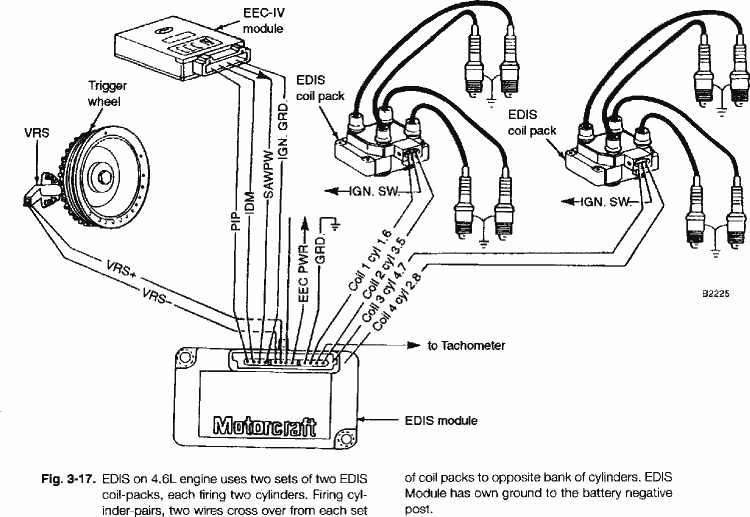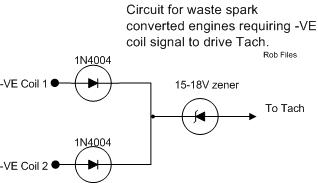Ford EDIS technical information
Ford EDIS general information
The Ford EDIS system consists of a controller module, coil packs and a crank trigger wheel sensor. Running alone, the EDIS module will fire the spark plugs at 10 degrees BTDC, operating in it's "limp home mode".
Normal operation involves interaction between the engine management system and the EDIS module, using the PIP and SAW as communication lines. After each ignition event, the EDIS module requests the current ignition advance value from the engine management unit using the PIP line. The engine management system calculates the current ignition advance and signals it back on the SAW input of the EDIS module. To communicate the advance value, the SAW reply signal is a pulse with a duration that corresponds to the amount of degrees advance.
The formula for calulating the SAW pulsewidth is as follows:
SAW Pulse width (uSec) = 1536 - (25.6 x (desired spark advance in degrees)) Range: 64 - 1792us (57.5° BTDC to 10° ATDC) Resolution: 4us (5/32nd of a degree)
The MegaJolt Lite Jr emulates the Ford engine management system, communicating the desired ignition advance value to the EDIS module calculated from it's internal configuration.
Trigger wheel and sensor mounting
Each EDIS application requires a different sensor mounting configuration. Use the following table to determine the correct sensor position in relation to the missing tooth and the engine's TDC.
| Sensor Position | |
| Type | Degrees BTDC |
|---|---|
| EDIS-4 | 90 |
| EDIS-6 | 60 |
| EDIS-8 | 50 |
With the Engine at TDC for cylinder #1, the sensor should be positioned 'N' degrees before the missing tooth. Make sure you take into account the rotation of the engine: clockwise or counter-clockwise when determining your sensor mounting.
For example: On an EDIS-4 application with the engine at Top Dead Center (TDC) - if the missing tooth is aligned with TDC (pointing up, or aligned with the crank pulley key), the sensor should be aligned with the center of the tooth 90 degrees BTDC. If this was a typical clockwise rotating engine, the sensor would be positioned 90 degrees to the left side of the crank sensor (9 o'clock position), when viewed facing the crank.

Shown: Relationship between engine Top Dead Center and sensor positioning. Wherever you place the sensor, the distance from the missing tooth must remain constant.
As long as the relation between the missing tooth and sensor remains constant, you can position the sensor at your convenience. In my case with a toyota 4AG motor, it was easier to mount the sensor on the exhaust side of the block, so I oriented the missing tooth so it pointed down, or opposite, of TDC. The sensor was still mounted 90 degrees BTDC, at the 3 o'clock position when facing the crank.
Interfacing with OEM Tach
Many OEM tachometers operate by sensing a high voltage kickback pulse from the coil. You can find out if you have one of these tachometers by connecting your auto's tach input to the MJLJ tach output. If you don't see activity on on the gauge then it is likely that your unit requires this HV kickback pulse.
If you are converting from single-coil distributor setup, your OEM tach will need to see the HV kickback pulse from both EDIS coil packs. Here's a simple circuit on how to extract both coil pack's HV pulse while maintaining electrical isolation.


